The Ball’s in Your Court program brings together KPE researchers, Varsity Blues athletes and coaches and Princess Margaret Cancer Care in the delivery of a program that leverages sport as a conduit to engage testicular cancer survivors in supportive care.
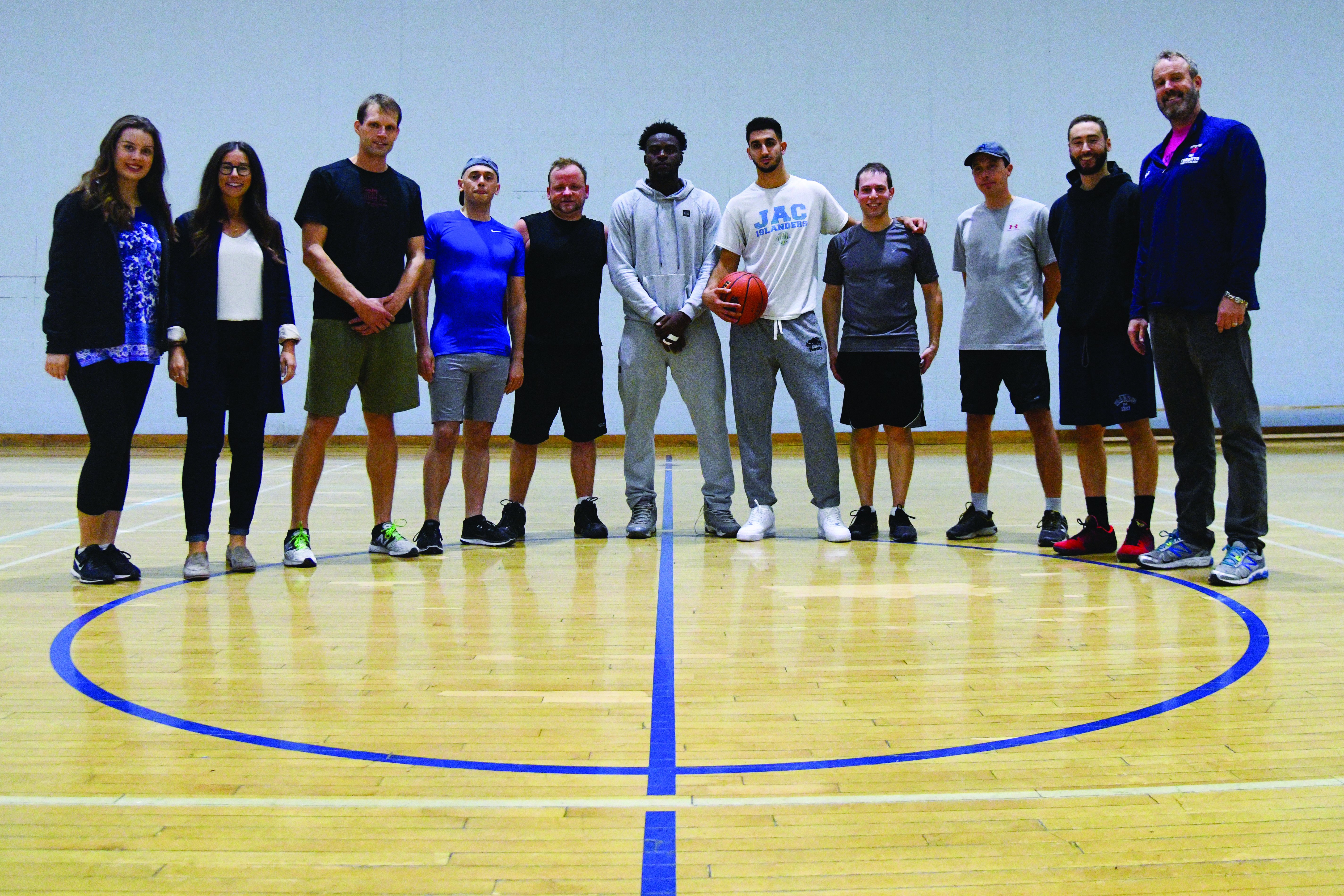
KPE researchers and Varsity Blues taking a picture break with participants of the Ball's in Your Court program
Although testicular cancer accounts for a little over one per cent of all male cancers, it is the most common cancer diagnosed in male adolescents and young adults in Canada. According to Canadian Cancer Society’s Advisory Committee on Cancer Statistics, incidence rates of testicular cancer have nearly doubled over the past 20 years, with approximately 1,100 new cases discovered each year.
The good news is that the majority of these cases are discovered early, with many survivors expected to have a long life expectancy following curative treatment. But, this also means that there is a growing community of young men in need of long-term follow-up care because testicular cancer survivors are at an increased risk of cardiovascular disease, secondary cancers and infertility. They also report higher levels of psychological distress compared to their peers.
“This is a very unique group of cancer patients,” says Doctor Robert J. Hamilton, a surgeon at the Princess Margaret Cancer Centre (PMCC), who oversees the testicular cancer program. “They are usually young men between the ages of 15 and 39. They may have just started a brand new job or they’re in the early parts of a relationship. Then they get told that they have cancer and it totally derails them. It’s very easy to fall off the societal map if you don’t have something to ground you,” he says.

Dr. Robert J. Hamilton and Paul Silvestri having a chat before the strength and conditioning session
Anika Petrella, a PhD candidate in the Health Behaviour and Emotion Lab at KPE, worked with Dr. Hamilton at the Princess Margaret Hospital as a clinical counsellor for testicular cancer survivors and noticed many of them were struggling.
“They don’t fit in the children’s hospital where the average age is six and they don’t fit in an adult hospital for cancer where the average age is 60-65, especially in genitourinary cancers,” says Petrella. “So, they kept asking me if there were any programs they could join with other testicular cancer survivors and there was nothing.”
Petrella went back to her PhD supervisor at KPE, Professor Catherine Sabiston, to put together a program that would improve the social support of testicular cancer survivors while giving them an opportunity to address their concerns with physical health and well-being. With Sabiston’s backing and assistance from Hamilton, she conducted a survey of 140 testicular cancer survivors treated at PMCC and discovered the men preferred interventions outside the hospital setting that are group based and geared towards their age and gender. The survey also revealed that testicular cancer survivors tend to be very active, but few were engaged in sport.
And so, The Ball’s in Your Court was conceived, bringing together KPE researchers, Varsity Blues athletes and coaches and PMCC in the delivery of a program that leverages sport as a conduit to engage testicular cancer survivors in supportive care. Hosted in the Faculty’s Athletic Centre, the program was spread over five weeks, with participants meeting each week for an hour of strength and conditioning, followed by an hour of basketball with the coach and volunteer athletes from the Varsity Blues men’s basketball team.
“In designing the program, we thought about all the physical activity spaces that we have available on campus,” says Sabiston, “and then we put out a call to our varsity coaches to see who would like to be involved.”
The response was overwhelming, but eventually they settled on basketball because it was easier to modify and widely accessible.
“The players really enjoyed interacting with the participants of the program,” says John Campbell, head coach of the Varsity Blues men’s basketball team. “They were of similar age and this was an opportunity for the players to gain some awareness about other people’s struggles while also contributing to their recovery. The best part has been seeing the smiles on everybody’s faces.”
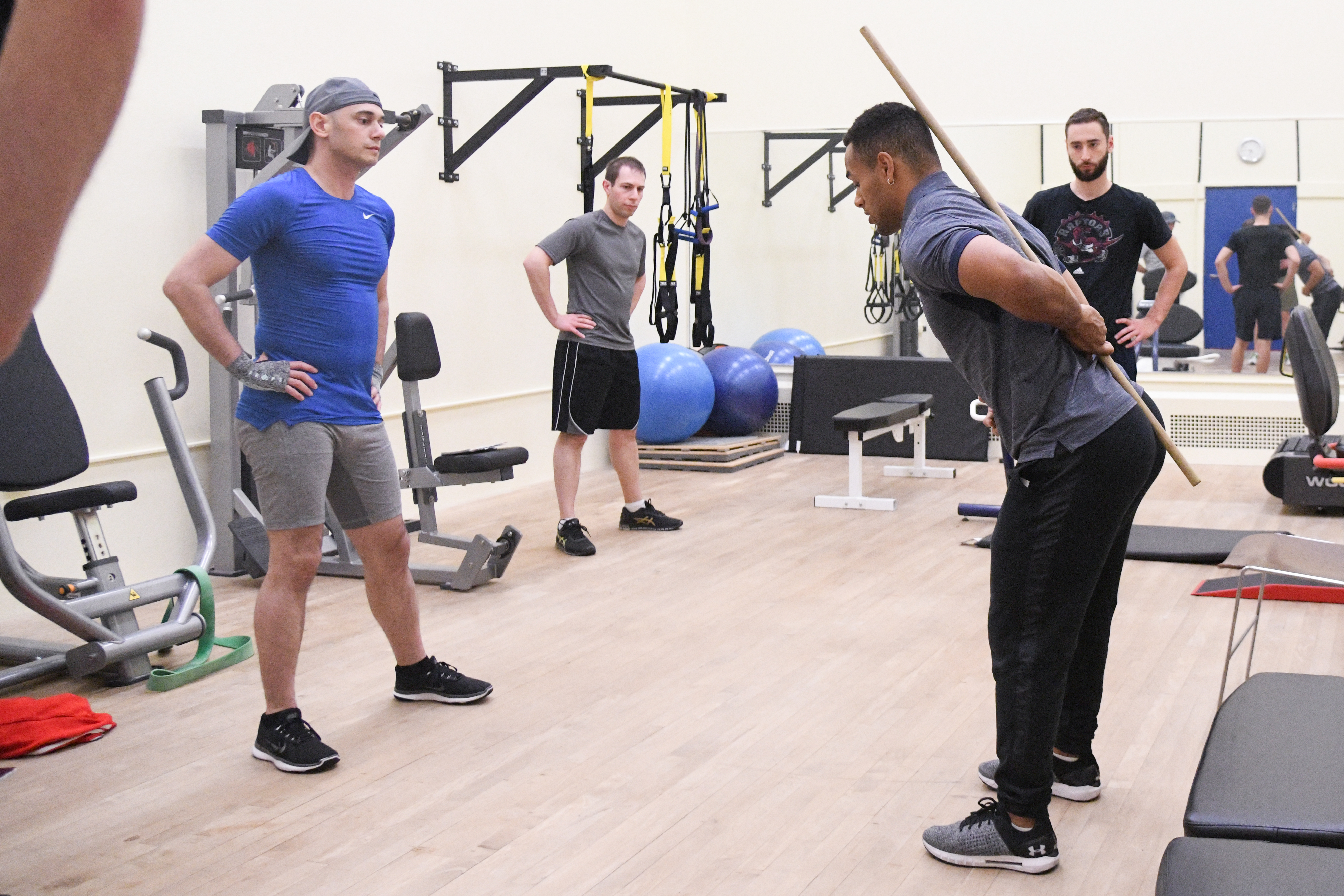
Strength and conditioning coach Alex Malone demonstrates an exercise
Alex Malone, strength and conditioning coach for the Varsity Blues, said he was surprised by the participants’ levels of self-determination.
“Their attitude was amazing. A couple of them came by to see the gym outside the regular program hours and some got memberships in other gyms. It’s cool to see how some of the stuff we did here influenced their life outside,” says Malone.
That’s an important part of the program, says Petrella, adding the participants were also supplied with a workbook to help them manage the side-effect of the disease and guide them on the path to healthy living.
“We’re trying to integrate new healthy behaviours into their lives that can have long term impact on their physical health. Men diagnosed with testicular cancer are living 50 plus years after curative treatment, so we need to reach them now so they make behavioural changes early,” she says.
The pilot program had 11 participants, including Paul Silvestri, an elementary school teacher and musician. He was diagnosed with stage 4 testicular cancer in 2017 at age 36. Following chemotherapy and multiple surgeries, he was glad to come across The Ball’s in Your Court program.
“Fitness and nutrition are a high priority of mine, so I just jumped on the chance to work out and do something sport specific,” he says.
But, it wasn’t easy. When Silvestri started the program, he was only four weeks out of a surgery, so he had to get medical clearance from his team of doctors. On day one, he felt he could barely participate, but he took it slowly.
“The second session I found I could do 40 per cent and, by going to the gym on other days throughout the week, I found that by the third session I could participate 50 per cent. By the fourth session I could do about 70 per cent,” he says.
Silvestri says his confidence grew when he saw that he was able to do more with every single session, even though he was still recovering from his surgeries. And since participating more in every session was proof that he was recovering very well, he was able to contend with the cancer process better.
“I felt more energized and I felt my strength, endurance and flexibility all improving dramatically,” he says.
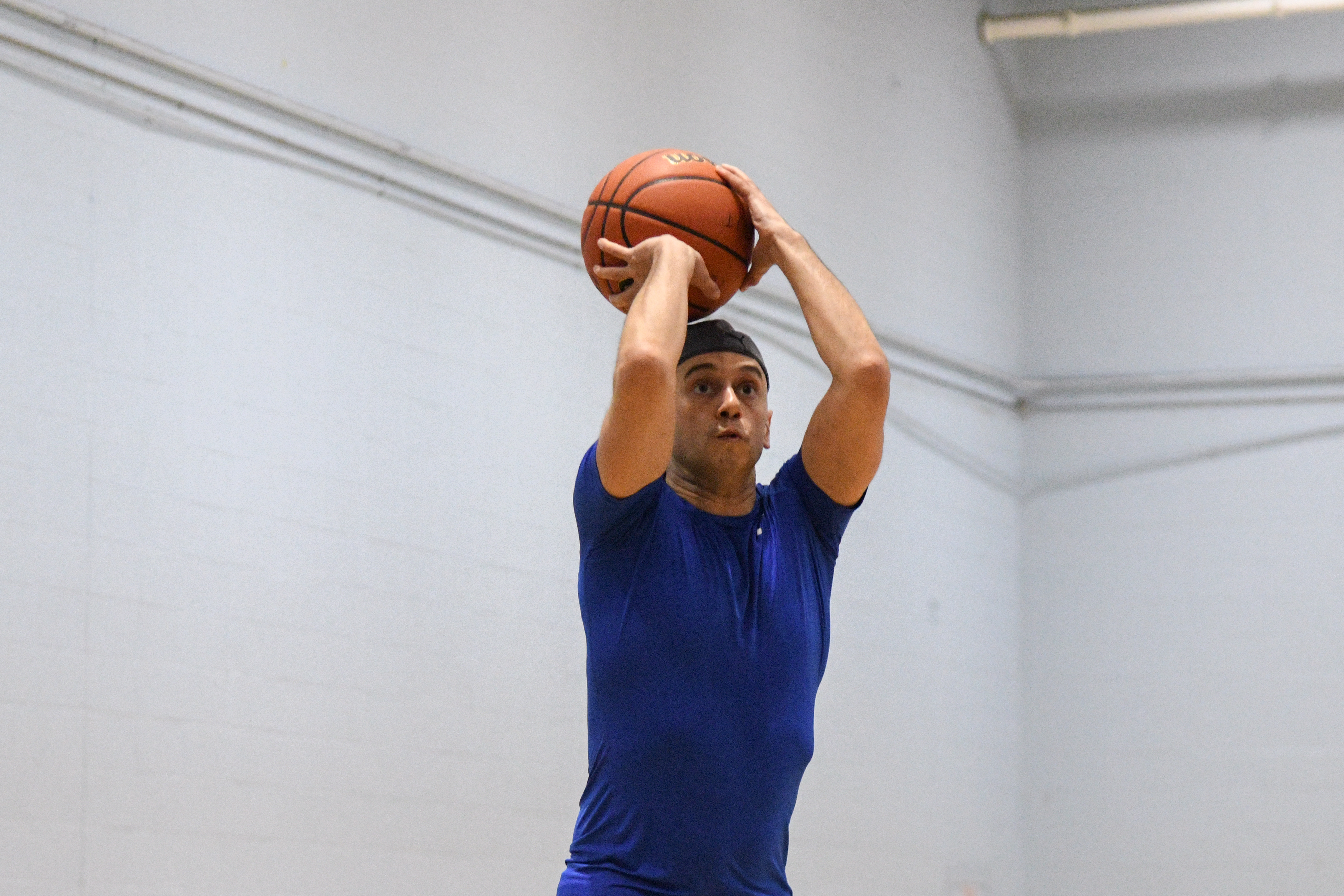
Paul Silvestri shoots to score
This is in line with Petrella’s findings, which point to the significant impact the program had on the participants’ perception of fatigue, strength, sense of control and social connectedness.
“After having two surgeries, I was very eager to get back to exercise for my own well-being and to gear up for my third and final surgery,” says Silvestri. “It was really important for me to be able to work out with other people and build camaraderie. Being on medical leave takes you out of your routines and can put a lot of other important things on hold, like dating. Exercise is something I love to do and I took full advantage of those moments to participate in order to feel like I had a little more of my life back.”
Hamilton, who treated the majority of the participants of the program, says men, especially young men, don’t do a good job talking about these things.
“So it’s not just the physical body that we’re tuning up here. It’s about the mental side of the recovery process. The general principle of cancer recovery is that you have to stay active, you have to keep going and try to get back to your normal life as quickly as possible, because there are physical and mental health benefits to doing that.”
Sabiston hopes the program can become a part of standard care to which Hamilton’s patients would have access. The other major goal would be to have a “program in a box,” something that can be disseminated to universities across Canada and globally.
“It’s my understanding that there is no program that links hospitals with varsity athletics programs anywhere in North America or the world. But, there is usually a hospital of some sort in most of the cities where there are big universities, so it makes for a natural fit,” she says, adding the program could also be used as an experiential learning opportunity for kinesiology students, who could lead some of the modules.
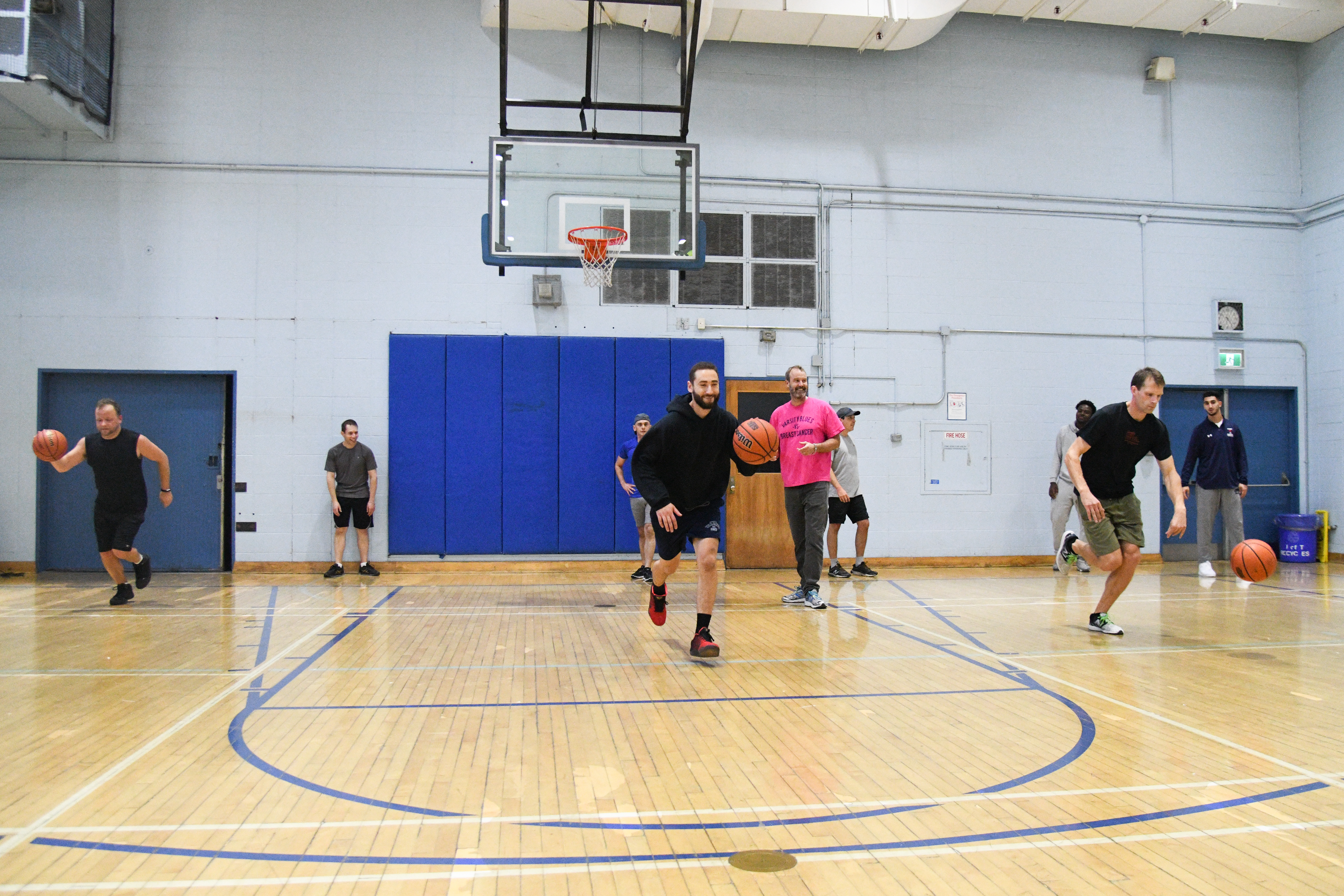
David Kuzmochka-Wilks, centre, volunteered for the Ball's in Your Court program
Recent KPE graduate David Kuzmochka-Wilks volunteered for the program, advising participants about different movement patterns, but primarily cheering them along.
“The very first time we played basketball, the energy was great and everybody was talking to each other, yelling and high fiving,” says Kuzmochka-Wilks. “I missed two sessions, but coming back and seeing the progression was amazing. You could see it working.”
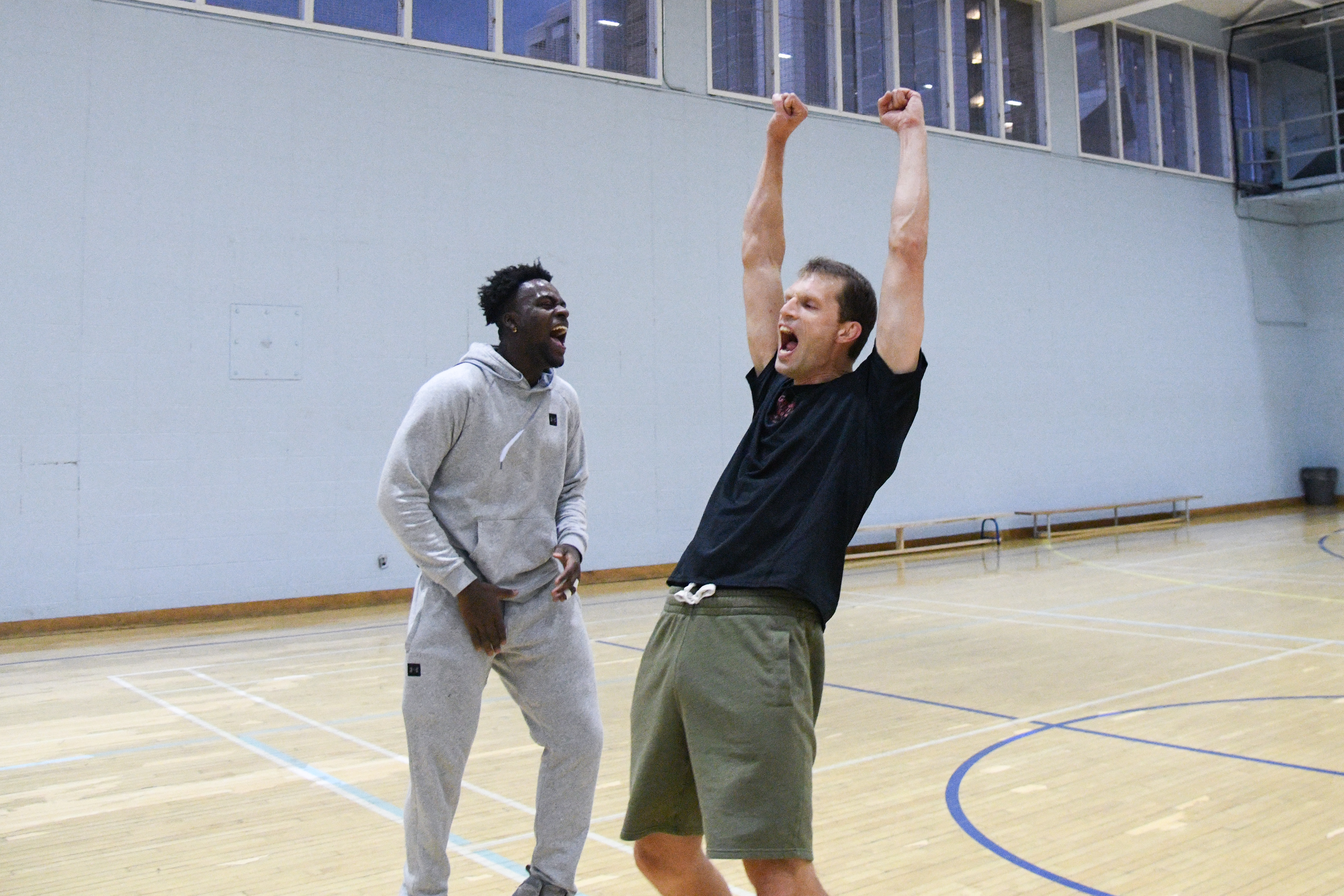
Varsity Blues basketball player Eli Mouyal and a participant of the Ball's in Your Court program celebrate a point
Seeing the participants enjoy the program also brought happiness to the varsity basketball players volunteering for the program.
“It was a great experience,” says Eli Mouyal, a student of psychology. “I really enjoyed the opportunity to be a mentor.”
“We all go through a lot of stuff in our lives and I was happy to be a part of a program like this,” adds his teammate Hassan Adenola, a third year kinesiology student.
Sabiston calls it a major collaborative event that came together naturally because so many people really believed in the idea.
On February 10, Silvestri was doing what he loves, performing at the Free Times Café on College Street. Asked to describe his set, he called it “Smashing Pumpkins and Radiohead meet classical music.” An unexpected combination, but it works, much like the program that supported his recovery.
*This story was originally published in Pursuit, the Faculty's alumni magazine.
